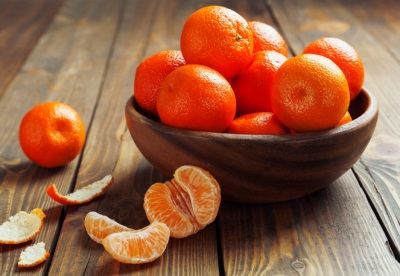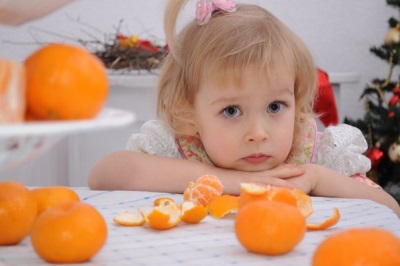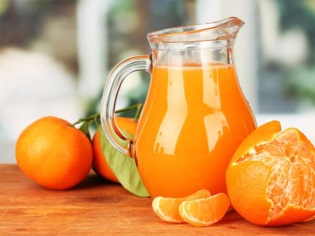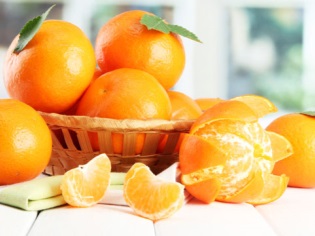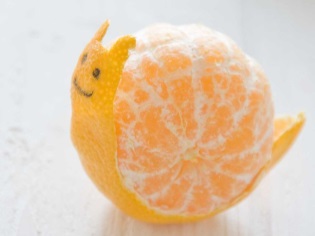At what age can I give mandarins to a child?
Such sweet and aromatic citrus fruits like mandarins are loved by many children and adults. They are associated with the holiday and are not only tasty, but also very useful in winter. At what age can you give a mandarin to a child for the first time, how can such a fruit be dangerous and how to choose the best mandarins for your baby?
Benefit
- Mandarin is a source of minerals and a variety of vitamins, among which are especially high in vitamin C, potassium, vitamin D, phosphorus, vitamins of group B, calcium and vitamin A.
- Due to the content of valuable essential oils such fruits improve mood, give energy for games and knowledge of the world, and also improve memory.
- High water content makes mandarin fruit, which remarkably quenches thirst.
- The use of mandarins has a positive effect on metabolic processes, intestinal function and glucose level.
- The tangerine juice has phytoncidal action, so it is recommended for respiratory and viral diseases, as well as during the recovery period after infections.
- Since the calorie content of the mandarin fruit is low, the fruit belongs to the diet and advise children with excess body weight.
- Fruits contain a sufficiently large amount of fiber, therefore, have a positive effect on digestive function.
Harm
- Like other types of citrus, mandarin belongs to the highly allergenic products.
- Due to the high sugar content, mandarin fruits should not be given to children with diabetes.
- The use of such citrus should be strictly metered in diseases of the stomach, when the acidity is increased, because it contains organic acids.
Contraindications
Mandarin should not treat a child with:
- Gastritis or peptic ulcer disease.
- Diabetes.
- Citrus intolerance.
- Hepatitis.
- Jade.
- Cholecystitis.
Why is there an allergy?
The development of allergy to the fruits of mandarin is often associated with hereditary predisposition. If one of the parents has intolerance to this type of fruit, then there is a high probability of its occurrence in the child.
The reaction to the mandarin can appear with an excessive amount of such citrus in the children's menu. Also, the body can respond to citrus allergies in diseases of the digestive tract.
The reaction to the fruits of the mandarin can be caused and chemicals that can be processed these fruits for longer storage.
What does a mandarin allergy look like?
The most common reaction to the use of mandarin is the appearance of a rash on the skin of a child. The skin may turn red and become edematous, and also begin to itch. Allergies often affect the eye mucosa, then the child's eyelids swell, tearing begins, the eyeballs turn red and itch.
Eating a fruit can also cause nasal congestion and the occurrence of an allergic rhinitis. Symptoms of a lesion in the respiratory system such as a dry cough, difficulty breathing, laryngeal edema, and a feeling of sore throat can join. The digestive tract can also react negatively to a mandarin - the appearance of abdominal pain, nausea, diarrhea, or even colitis.
Can I give a one-year-old child?
Most pediatricians are advised to acquaint the crumb with tangerines after 12 months. First, give your baby some juice of this citrus, not forgetting to half dilute it with water. Next karapuzu can try mandarin lobule. If the child responded to it normally, the number of lobules is gradually increased to one or two mandarins per day.
From what age is it better to put it in complementary foods?
In the absence of the propensity for allergies to enter into the children's diet mandarin is advised from 1 year. If the child had cases of allergic reactions to any food, familiarity with all citrus fruits, including tangerines, should be postponed until the age of 3 years.
In what form can I give?
Mandarin appears in the child’s diet most often:
- In the form of fresh juice. Fresh tangerine is cut into two halves and using a citrus press or simply squeezing it tightly with your hand, squeeze the fruit out of the fruit. Then it is diluted with the same amount of purified water and offered to the child.
- In the form of fresh fruit. Tangerines are peeled and divided into lobules. The smallest children with lobules are advised to remove white skin to make it easier to chew the flesh. If there are bones in the fruit, they must be removed and discarded.
Tips for choosing
- Estimate the weight of the fetus visually, and then take the mandarin in your hand or weigh it. If the fruit is ripe, its weight will be less than it seemed to you at first glance. Immature fruits will be dense and heavy.
- The skin of the fruit must be complete. If the tangerines have dark spots, cracks, rotten areas, in any case, do not buy them for children.
- Do not buy excessively soft fruits, because inside such mandarins can be rotten. Also, do not take fruit with a stiff or sluggish skin, as such citrus fruits are overripe.
- Choose mandarins for a child only in places where the products have all the necessary documentation. Take an interest in the place where fruits are grown - the hotter it is, the sweeter the tangerines will be.

